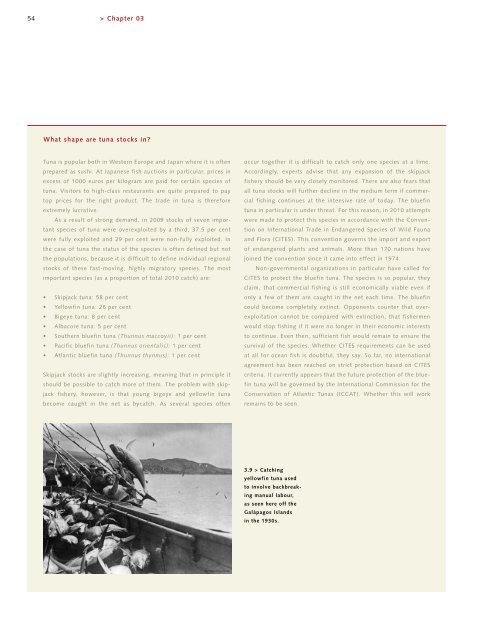Download WOR 2 PDF - World Ocean Review
Download WOR 2 PDF - World Ocean Review
Download WOR 2 PDF - World Ocean Review
Create successful ePaper yourself
Turn your PDF publications into a flip-book with our unique Google optimized e-Paper software.
54> Chapter 03What shape are tuna stocks in?Tuna is popular both in Western Europe and Japan where it is oftenprepared as sushi. At Japanese fish auctions in particular, prices inexcess of 1000 euros per kilogram are paid for certain species oftuna. Visitors to high-class restaurants are quite prepared to paytop prices for the right product. The trade in tuna is thereforeextremely lucrative.As a result of strong demand, in 2009 stocks of seven importantspecies of tuna were overexploited by a third, 37.5 per centwere fully exploited and 29 per cent were non-fully exploited. Inthe case of tuna the status of the species is often defined but notthe populations, because it is difficult to define individual regionalstocks of these fast-moving, highly migratory species. The mostimportant species (as a proportion of total 2010 catch) are:• Skipjack tuna: 58 per cent• Yellowfin tuna: 26 per cent• Bigeye tuna: 8 per cent• Albacore tuna: 5 per cent• Southern bluefin tuna (Thunnus maccoyii): 1 per cent• Pacific bluefin tuna (Thunnus orientalis): 1 per cent• Atlantic bluefin tuna (Thunnus thynnus): 1 per centSkipjack stocks are slightly increasing, meaning that in principle itshould be possible to catch more of them. The problem with skipjackfishery, however, is that young bigeye and yellowfin tunabecome caught in the net as bycatch. As several species oftenoccur together it is difficult to catch only one species at a time.Accordingly, experts advise that any expansion of the skipjackfishery should be very closely monitored. There are also fears thatall tuna stocks will further decline in the medium term if commercialfishing continues at the intensive rate of today. The bluefintuna in particular is under threat. For this reason, in 2010 attemptswere made to protect this species in accordance with the Conventionon International Trade in Endangered Species of Wild Faunaand Flora (CITES). This convention governs the import and exportof endangered plants and animals. More than 170 nations havejoined the convention since it came into effect in 1974.Non-governmental organizations in particular have called forCITES to protect the bluefin tuna. The species is so popular, theyclaim, that commercial fishing is still economically viable even ifonly a few of them are caught in the net each time. The bluefincould become completely extinct. Opponents counter that overexploitationcannot be compared with extinction, that fishermenwould stop fishing if it were no longer in their economic intereststo continue. Even then, sufficient fish would remain to ensure thesurvival of the species. Whether CITES requirements can be usedat all for ocean fish is doubtful, they say. So far, no internationalagreement has been reached on strict protection based on CITEScriteria. It currently appears that the future protection of the bluefintuna will be governed by the International Commission for theConservation of Atlantic Tunas (ICCAT). Whether this will workremains to be seen.3.9 > Catchingyellowfin tuna usedto involve backbreakingmanual labour,as seen here off theGalápagos Islandsin the 1930s.
















